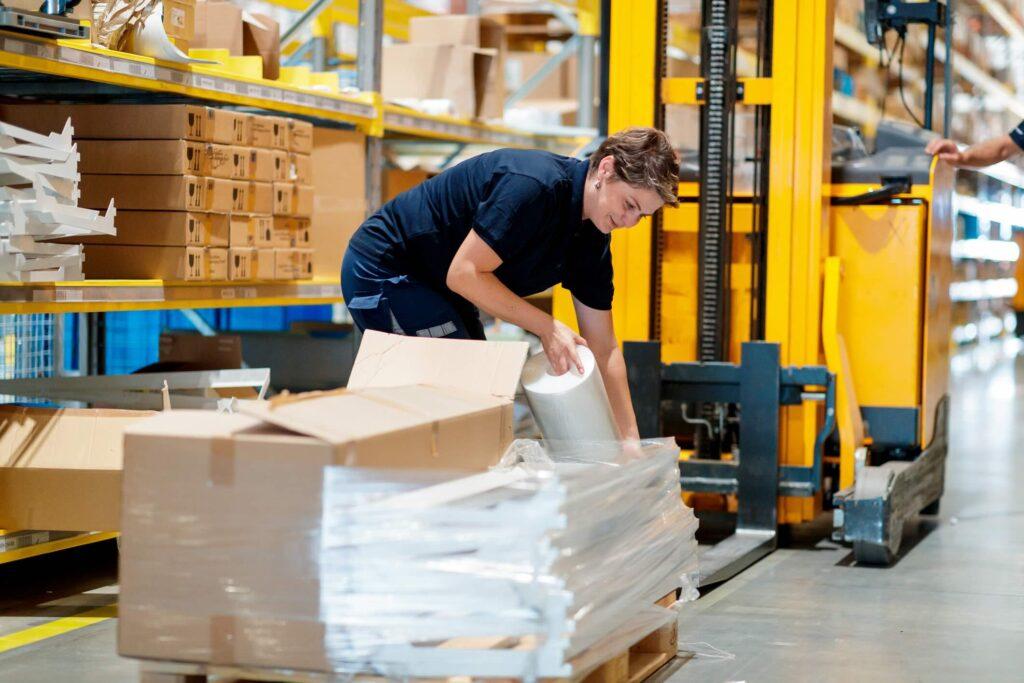Reducing plastic waste is one of the leading methods to reduce our environmental impact. Sustainability is a growing issue, and companies are looking for ways to reduce plastic usage without compromising performance.
For warehouse operators, a primary application of plastic is stretch film usage. Goods are wrapped in stretch wrap to protect their contents and secure them in place for storage or transport. How can warehouses across the US ensure they are minimizing their stretch film usage and achieve their sustainability goals, all without compromising the protection of their goods?
1. Choosing the right stretch film
Did you know that damaged goods can create more waste for the environment than the plastic packaging itself? With that in mind, it’s imperative that warehouse operators choose the right film for their products.
Stretch film comes in different types, from the production method to the customization used to differentiate products. For instance, blown stretch film will naturally have incredible strength and is well suited to sharp-edged goods, as it is incredibly hard to tear. Warehouse operators should review the performance of their films and ensure they are choosing the right film for their operation. This could depend on load type, the equipment used to wrap products, the film’s properties, and more. Speak to an expert on stretch film to ensure you aren’t investing in wrap that will actually result in more harm than good for your products.
2. Use thinner film
Certain types of stretch film naturally have lower waste, such as in the case of cast film, which is created through a cast manufacturing process. The resulting film is clear, consistent, but crucially, thin. It also has a strong cling, adhering well to itself and the products being wrapped, preventing load shifting and unnecessary damage during transport.
Warehouse operators should determine the minimal gauge that will be adequate to protect their products. The lower the gauge, the less film will be needed to wrap goods. However, the goal must still be to ensure the quality of the product, as damage during transit will result in more waste than the stretch film itself.
3. Ensure proper tension
When it comes to securing loads, it’s not just about the thickness of the gauge, but also the tension of the film. This tension, or containment force, is how much force is being applied to the load at any given time. It’s usually measured in pounds, with light loads (under 500 lbs) only requiring a few pounds of force, while unstable heavy loads may require above 20 pounds of force.
Warehouse operators should ensure:
- The stretch film’s containment force is equal across the entirety of the load to reduce the risk of uneven load shift.
- The film is overlapped correctly to reduce the potential of weak areas.
- The right amount of force is used so as not to damage the products or packaging boxes.
- The film is adequately wrapped down onto the pallet, securing everything in place.
Operators needing a precise amount of tension may wish to use a pull test kit, allowing workers to check the film’s containment force on the fly.
4. Use pre-stretched film
Film memory is a key aspect of reducing stretch film usage. Warehouses often pre-stretch film to create a memory in the film, causing elasticity as the film attempts to shrink back to its original state.
This elasticity increases the wrap’s surface area while reducing the risk of load shifting during transit, as the film is keeping itself in place. Operators could invest in pre-stretched film to reduce damage during transit, allowing the elasticity to pick up the slack when settling during transit loosens other methods of strapping down products.
5. Optimize wrapping technique
The right wrapping technique can make the difference between a loose and secure load. Workers should ensure they:
- Apply the film in the right direction: All stretch wrap has a sticky and smooth side. The sticky side should face inwards, protecting the product, while the glossy side is kept on the exterior to allow goods to slide against each other without tearing. Keep in mind that warehouses may package stretch wrap with the tacky side on the outside or on the inside, and workers should identify the sticky side before starting to wrap the product.
- Sufficiently overlap the film: Film should overlap to ensure stability, but too much overlap is wasteful. A rule of thumb is to aim for 30-50% overlap on each turn of the film.
6. Invest in automation
A pallet rolling machine can save time and money, all while reducing stretch film usage. Setting the machine to optimally use stretch film and give appropriate load stability can seem complicated, but there are a few steps workers can follow:
- Ensure the film type is right for the machine.
- Check the weight of the used stretch wrap to ensure there’s no waste.
- Clean the rollers before use.
- Check the stretch film is threaded correctly according to the machine’s diagram.
- Adjust the turntable speed for ideal film overlap.
- Test the containment force either by hand or using a pull test kit.
- Consult with the machine’s operators.
An optimally set pallet rolling machine can overhaul a warehouse’s entire way of working. It also means there’s no human error in the amount of stretch wrap being applied to products, potentially reducing stretch film usage by drastic amounts over time.
7. Use pallet bands
A pallet banding solution like sanstrap® secures the top layer of a pallet. It allows warehouse operators to quickly and easily stabilize a pallet for transport within a warehouse.
By investing in sanstrap®, workers don’t have to wrap an entire pallet in film just to move it around the plant. It removes the need for stretch film, tape, rubber bands, or even twine. The band can be applied in nine seconds or less, is recyclable, durable, and prevents damage. Warehouses could use pallet bands to speed up their operation and achieve their sustainability goals, all while reducing labor costs.
Experts can help reduce your stretch film usage further
Implementing these strategies will save warehouses money and improve sustainability.
Operators should consult with stretch film experts to best understand which type of film they should use, how thin it can be, whether it has the right tension, and when to use pre-stretched film. Workers should be trained on the optimal ways to wrap products, as well as on how to operate automatic machines to reduce waste even further. Additional techniques such as pallet bands will further save on resource and labor costs, helping companies meet the needs of a greener world.
Looking to reduce your stretch film usage? Contact an expert from our team online or call us at +1 216-486-9400.

